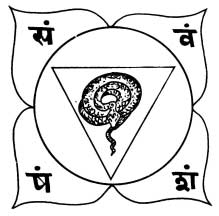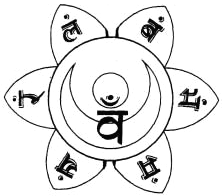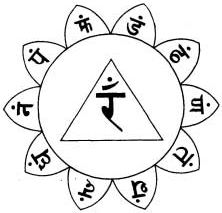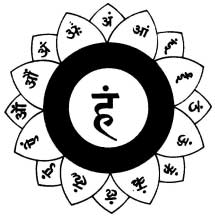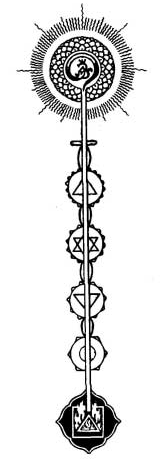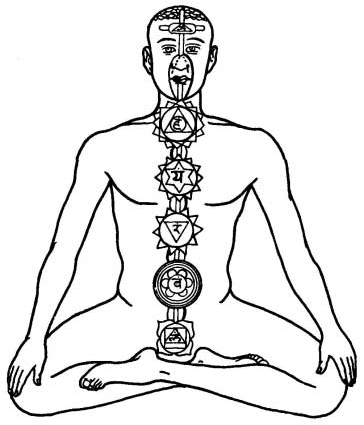CHAPTER III
Which Is Right For You?
In ancient times yoga was often referred to as a tree, a living entity with roots, a
trunk, branches, blossoms, and fruit. Hatha yoga is one of six branches; the
others include raja, karma, bhakti, jnana, and tantra yoga. Each branch with its
unique characteristics and function represents a particular approach to life.
Some people may find one particular branch more inviting than another.
However, it is important to note that involvement in one of these paths does not
preclude activity in any of the others, and in fact you'll find many paths naturally
overlapping.
RAJA YOGA
Raja means "royal," and meditation is the focal point of this branch of yoga. This
approach involves strict adherence to the eight "limbs" of yoga as outlined by
Patanajli in the Yoga Sutras. Also found in many other branches of yoga, these
limbs, or stages, follow this order: ethical standards, yama; self-discipline,
niyama; posture, asana; breath extension or control, pranayama; sensory
withdrawl, pratyahara; concentration, dharana; meditation, dhyana; and ecstasy
or final liberation, samadhi.
Raja yoga attracts individuals who are introspective and drawn to meditation.
Members of religious orders and spiritual communities devote themselves to
this branch of yoga. However, even though this path suggests a monastic or
contemplative lifestyle, entering an ashram or monastery is not a prerequisite to
practicing raja yoga.
KARMA YOGA
The next branch is that of karma yoga or the path of service, and none of us can
escape this pathway. The principle of karma yoga is that what we experience
today is created by our actions in the past. Being aware of this, all of our present
efforts become a way to consciously create a future that frees us from being
bound by negativity and selfishness.
Karma is the path of self-transcending action. We practice karma yoga whenever
we perform our work and live our lives in a selfless fashion and as a way to serve
others. Volunteering to serve meals in a soup kitchen or signing up for a stint
with the Peace Corps or Habitat for Humanity are prime examples of selfless
service associated with the karma yoga path.
BHAKTI YOGA
Bhakti yoga describes the path of devotion. Seeing the divine in all of creation,
bhakti yoga is a positive way to channel the emotions. The path of bhakti
provides us with an opportunity to cultivate acceptance and tolerance for
everyone we come into contact with. Bhakti yogis express the devotional nature
of their path in their every thought, word, and deed—whether they are taking out
the trash or calming the anger of a loved one. Mahatma Gandhi and Martin
Luther King, Jr., are prime examples of bhakti yogis. The life and work of
Mother Teresa epitomize the combination of the karma and bhakti yoga paths
with devotional aspects of bhakti and the selfless service of karma yoga.
JNANA YOGA
If we consider bhakti to be the yoga of the heart, then jnana yoga is the yoga of
the mind, of wisdom, the path of the sage or scholar. This path requires
development of the intellect through the study of the scriptures and texts of the
yogic tradition. The jnana yoga approach is considered the most difficult and at
the same time the most direct. It involves serious study and will appeal to those
who are more intellectually inclined. Within the context of our Western religious
traditions, Kabalistic scholars, Jesuit priests, and Benedictine monks epitomize
jnana yogis.
TANTRA YOGA
Probably the most misunderstood or misinterpreted of all the yogas, tantra, the
sixth branch, is the pathway of ritual, which includes consecrated sexuality. The
key word here is "consecrated," which means to make sacred, to set apart as
something holy or hallowed. In tantric practice we experience the Divine in
everything we do. A reverential attitude is therefore cultivated, encouraging a
ritualistic approach to life. It is amusing to note that, although tantra has
become associated exclusively with sexual ritual, most tantric schools actually
recommend a celibate lifestyle.
In essence, tantra is the most esoteric of the six major branches. It will appeal to
those yogis who enjoy ceremony and relate to the feminine principle of the
cosmos, which yogis call shakti. If you see—and are deeply moved by—the
significance behind celebration and ritual (holidays, birthdays, anniversaries,
and other rites of passage), tantra yoga may be for you. Many tantric yogis find
magic in all types of ceremony, whether it be a Japanese tea ceremony, the
consecration of the Eucharist in a Catholic mass, or the consummation of a
relationship.
ASHTANGA YOGA
One of the most popular schools of yoga practice today is that of Ashtanga Yoga.
Ashtanga literally means “eight limbs”. These eight steps (limbs) basically act as
guidelines on how to live a meaningful and purposeful life. They serve as a
prescription for moral and ethical conduct and self-discipline; they direct
attention toward one's health; and they help us to acknowledge the spiritual
aspects of our nature.
The first limb, yama, deals with one's ethical standards and sense of integrity,
focusing on our behavior and how we conduct ourselves in life. Yamas are
universal practices that relate best to what we know as the Golden Rule, "Do
unto others as you would have them do unto you."
Niyama, the second limb, has to do with self-discipline and spiritual
observances. Regularly attending temple or church services, saying grace before
meals, developing your own personal meditation practices, or making a habit of
taking contemplative walks alone are all examples of niyamas in practice.
Asanas, the postures practiced in yoga, comprise the third limb. In the yogic
view, the body is a temple of spirit, the care of which is an important stage of our
spiritual growth. Through the practice of asanas, we develop the habit of
discipline and the ability to concentrate, both of which are necessary for
meditation.
Generally translated as breath control, this fourth stage consists of techniques
designed to gain mastery over the respiratory process while recognizing the
connection between the breath, the mind, and the emotions. As implied by the
literal translation of pranayama, "life force extension," yogis believe that it not
only rejuvenates the body but actually extends life itself. You can practice
pranayama as an isolated technique (i.e., simply sitting and performing a
number of breathing exercises), or integrate it into your daily hatha yoga
routine.
These first four stages of Patanjali's ashtanga yoga concentrate on refining our
personalities, gaining mastery over the body, and developing an energetic
awareness of ourselves, all of which prepares us for the second half of this
journey, which deals with the senses, the mind, and attaining a higher state of
consciousness.
Pratyahara, the fifth limb, means withdrawal or sensory transcendence. It is
during this stage that we make the conscious effort to draw our awareness away
from the external world and outside stimuli. Keenly aware of, yet cultivating a
detachment from, our senses, we direct our attention internally. The practice of
pratyahara provides us with an opportunity to step back and take a look at
ourselves. This withdrawal allows us to objectively observe our cravings: habits
that are perhaps detrimental to our health and which likely interfere with our
inner growth.
As each stage prepares us for the next, the practice of pratyahara creates the
setting for dharana, or concentration. Having relieved ourselves of outside
distractions, we can now deal with the distractions of the mind itself. No easy
task!
In the practice of concentration, which precedes meditation, we learn how to
slow down the thinking process by concentrating on a single mental object: a
specific energetic center in the body, an image of a deity, or the silent repetition
of a sound. We, of course, have already begun to develop our powers of
concentration in the previous three stages of posture, breath control, and
withdrawal of the senses. In asana and pranayama, although we pay attention to
our actions, our attention travels. Our focus constantly shifts as we fine-tune the
many nuances of any particular posture or breathing technique. In pratyahara
we become self-observant; now, in dharana, we focus our attention on a single
point. Extended periods of concentration naturally lead to meditation.
Meditation or contemplation, the seventh stage of ashtanga, is the uninterrupted
flow of concentration. Although concentration (dharana) and meditation
(dhyana) may appear to be one and the same, a fine line of distinction exists
between these two stages. Where dharana practices one-pointed attention,
dhyana is ultimately a state of being keenly aware without focus. At this stage,
the mind has been quieted, and in the stillness it produces few or no thoughts at
all. The strength and stamina it takes to reach this state of stillness is quite
impressive. But don't give up. While this may seem a difficult if not impossible
task, remember that yoga is a process. Even though we may not attain the
"picture perfect" pose, or the ideal state of consciousness, we benefit at every
stage of our progress.
Patanjali describes this eighth and final stage of ashtanga as a state of ecstasy. At
this stage, the meditator merges with his or her point of focus and transcends
the Self altogether. The meditator comes to realize a profound connection to the
Divine, interconnectedness with all living things. With this realization comes the
"peace that passeth all understanding"; the experience of bliss and being at one
with the Universe.
On the surface, this may seem to be a rather lofty, "holier than thou" kind of
goal. However, if we pause to examine what we really want to get out of life,
would not joy, fulfillment, and freedom somehow find their way onto our list of
hopes, wishes, and desires?
What Patanjali has described as the completion of the yogic path is what, deep
down, all human beings aspire to: peace. We also might give some thought to the
fact that this ultimate stage of yoga—enlightenment—can neither be bought nor
possessed. It can only be experienced, the price of which is the continual
devotion of the aspirant ok, now that we’ve got that out of the way, let’s prep the
environment and get you ready for your yoga workout!
THE SERPENTINE POWERS
The Serpentine Power is called Kundalini-Sakti on account of its spiral-like
working in the body of the Yogi developing the power in himself. It is an electric
fiery occult power, the mighty pristine force underlying all organic and inorganic
matter. The Yoga which treats of this Kundalini-Sakti is called Kundalini-Yoga.
Kundalini is the Divine Cosmic Energy in bodies. Siddhi or perfection in Yoga is
achieved by arousing this Supreme Force which is lying dormant in the
Muladhara Chakra at the base of the spinal column in the form of a serpent with
3 1/2 coils. That Yogi in whom the Kundalini is awakened and taken towards the
top of the head is the real King of kings or Emperor of emperors. He has all
divine powers. All Siddhis and Riddhis (minor powers) roll under his feet. He
can command Nature. He can command the five elements. His glory is
indescribable.
Before proceeding to know something about the Chakras and the Kundalini-
Sakti it is essential to know something about the spinal column and the Nadis or
nerve-currents. The spinal column is called Meru-danda , and it extends from
the Kanda (situated between the anus and the root of the reproductory organ) to
the base of the skull. There are two Nadis on either side of the spinal column
called I d a a n d Pingala , and between these two runs a hollow canal called
Sushumna at the lower extremity of which lies the Kundalini-Sakti sleeping a
trance-sleep ( Yoga Nidra ). Ida starts from the right testicle and Pingala from the
left, and they both meet the Sushumna at the Muladhara Chakra. Ida flows
through the left nostril and Pingala through the right. Ida is cooling, while
Pingala is heating. Sushumna which originates at the Muladhara Chakra runs
right up to the top of the head. Ida and Pingala indicate time; Sushumna is the
devourer of time. When the Prana flows through the Sushumna, “the most
highly beloved of the Yogins”, the mind becomes quite steady.
The Yogi defies death by devitalising Ida and Pingala and taking the Prana
through the Sushumna to the crown of the head or Brahmarandhra (Seat of
Brahman). When the Kundalini is awakened, it forces its way through the
Sushumna, and its progress is characterized by supernatural visions, acquisition
of various special powers, knowledge, peace and bliss. When the Kundalini is
taken to the Sahasrara Chakra (at the top of the head). The Yogi enjoys Supreme
Bliss.
When the Kundalini enters the Sushumna Nadi, the Prana also enters the
Sushumna of itself along with the Kundalini. Regular practice of Uddiyana
Bandha awakens the Kundalini and enables it to rise upwards along the
Sushumna. This is a powerful Yogic Kriya. All Kundalini enthusiasts should
practice this daily. The practice of Yoga-Asanas, Pranayama, Mudras and
Bandhas is prescribed only to awaken the Kundalini. These are all potent
practices in rousing this great pristine force.
A detailed knowledge of Nadis (psychic nerves or astral tubes for carrying Prana)
and the Chakras (lotuses or psychic nerve-currents) is of paramount importance
for all students of Kundalini-Yoga. The psychic nerve lodged in the hollow of the
spinal column is the chief or medium Nadi. It is called the Sushumna Nadi. Just
as electricity is stored up in dynamos, so also the vital force (Prana) is stored up
in the Chakras and the Sushumna Nadi. Prana plays a vital part in all psycho-
physical processes. The first attempt on the part of the young Kundalini-Yogi is
the purification of the Nadis which will lead to the opening of the Sushumna
which generally remains closed up in all worldly-minded people.
All students of Kundalini-Yoga should possess a clear and sound knowledge of
the six Chakras. Then only they can contemplate on these Chakras. Meditation
on these Chakras brings psychic powers. A Chakra means a centre of spiritual
energy. The different plexuses in the human body correspond tentatively to the
different Chakras in the astral (Sukshma) body. Otherwise Hatha-Yoga is
impossible. There is difference of opinion as to where the Chakras are really
located. Doctors dissect the physical body. They are not able to find the centers,
lotuses and so forth. Some say that the Chakras are situated only in the astral
body. Some others maintain that the Chakras are developed during the course of
meditation through the force of Dhyana (contemplation), and that they are not
in the astral body. This is the real truth viz., that the Chakras are in a dormant
state in the Pranayama Kosha (vital air-sheath) of the astral body and that
they become opened owing to intense and deep meditation .
There are six subtle Chakras or centres or lotuses in this Sushumna Nadi. These
a r e Muladhara, Svadhishthana, Manipura, Anahata, Vishuddha a n d Ajna .
Above all these there is the Sahasrara , the chief of all the centres. All the
Chakras are intimately connected with the Sahasrara Chakra. Hence it is not
included as one among the six Chakras. Sahasrara is situated above all the six
Chakras at the top of the head.
The MULADHARA CHAKRA is situated between the root of the reproduction
organ and the anus at the base of the spinal column. It is here, as I have already
mentioned, that the two Nadis, Ida and Pingala, meet the Sushumna. The
Muladhara Chakra is two fingers above the anus and two fingers below the
genitals and four fingers in width. It has four petals of crimson hue. In the
pericarp of this Chakra there is a beautiful triangle in which the sleeping
Kundalini of the form of a coiled-up serpent dwells. She holds her tail in her
mouth and covers the mouth of the Brahma-dvara (the gateway to the Seat of
Brahman) with her head. The Yogi who concentrates on the Muladhara Chakra
gets full knowledge of the Kundalini and the various means to rouse it to action.
As soon as the Kundalini is roused, the Yogi gets the power to rise up above the
ground. He gets full control over his breath, mind and semen. His Prana flows
through the Sushumna and all his sins are destroyed. He gets knowledge of the
past, present and future. He is immensely happy.
MULADHARA CHAKRA
The SVADHISHITHANA CHAKRA is located within the Sushumna at the
root of the sexual organ. It has six petals and is pure blood-like red (vermilion)
in color. Concentration on this Chakra frees the Yogi from fear of water. He gets
several other psychic powers, intuitional knowledge and freedom from the faults
of the mind and the senses. He becomes an object of love and adoration to all
beautiful goddesses, and recites all the Sastras unknown to him before. He
becomes the conqueror of death and moves throughout the universe fearlessly.
SVADHISHTHANA CHAKRA
The MANIPURA CHAKRA is situated within the Sushumna in the region of
the navel and is the third Chakra from the Muladhara. It is of the color of yellow
clouds and has ten petals. It is the solar-plexus or “city of gems” because it is
very brilliant. Meditation on this excellent Chakra bestows power to destroy and
create worlds. The Goddess of Speech, Saraswati, ever dwells in the face of the
Yogi. He gets knowledge of the hidden treasures and is freed from all kinds of
diseases. He has no fear at all from fire. He can make gold and see Siddhas or
Adepts clairvoyantly.
MANIPURA CHAKRA
The ANAHATA CHAKRA is located in the Sushumna in the region of the
heart. It is of a green color and has twelve petals. The Anahata sound, the sound
of Shabda-brahman, is heard at this centre. You can clearly hear this sound if
you concentrate silently at this lotus. He who concentrates on this Chakra gets
full control over air. He can fly in the air, enter the body of another and become
prosperous. He becomes wise and does only noble deeds. He gets cosmic love
and all other divine virtues.
ANAHATA CHAKRA
The VISUDDHA CHAKRA is situated at the base of the throat within the
Sushumna. Its color is blue and has sixteen petals. Concentration on this Chakra
enables the Yogi to attain the highest success. He does not perish even during
the Pralaya (Great Deluge). He gets full knowledge of the four Vedas and
becomes the knower of the three periods of time (past, present and future). He
becomes eloquent, wise, enjoys peace of mind, and it is said that by his Yogic
power he can move the three worlds.
VISUDDHA CHAKRA
The AJNA CHAKRA is situated in the Sushumna between the eyebrows. This
is also known as Trikuti. This is the seat of the mind. This Chakra has two petals
and is of beautiful indigo color. He who concentrates on this most excellent
Chakra destroys all Karmas or actions of the past lives and becomes a
Jivanmukta (living liberated sage). He gets all the eight major Siddhis and the
thirty-two minor Siddhis.
AJNA CHAKRA
The SAHASRARA CHAKRA is the thousand-petalled lotus at the top of the
head and is the Abode of Lord Siva. When the Kundalini is awakened, it pierces
one Chakra after another and finally unites with Lord Siva and enjoys the
Highest Bliss. Now the Yogi attains super conscious state and becomes a full-
blown Jnani. He drinks the Nectar of Immortality. Illustration shows the ascent
of the Kundalini to the top of the head and its union with Lord Siva.
When the Kundalini is awakened, it does not directly proceed all at once to the
Sahasrara Chakra. You will have to take it from one Chakra to another. You will
certainly live even after it is taken to the Sahasrara. But remember that even
after it is taken to the Sahasrara, it may drop down to the Muladhara at any
moment! Only when you are firmly established in Samadhi, when you have
attained Kaivalya, the Kundalini cannot and does not drop down. Illustration
gives a rough idea as to how the Kundalini, when aroused, reaches the top of the
head after piercing one Chakra after another.
Do not mistake, my dear Kundalini brothers! O ye enthusiastic and emotional
young Yogins! the movement of the rheumatic winds in the back due to the
chronic lumbago for the ascent of Kundalini. Do your Sadhana with patience,
perseverance, cheerfulness and courage, till you get the Nirvikalpa Samadhi.
It is easy to awaken the Kundalini, but it is very difficult to take it up to the
navel, to the Ajna Chakra, and thence to the Sahasrara in the head. It demands a
great deal of patience and persistence on the part of the practitioner. But there is
nothing impossible for a man of determination and iron-will. That Yogi who has
taken the Kundalini to the Sahasrara is the real master of the forces of Nature.
Generally Yogic students abandon their Sadhana on account of false satisfaction.
They foolishly imagine that they have reached the goal, when they get some
mystic experiences and powers. This is a mistake. Complete Asamprajnata
Samadhi (Nirvikalpa Samadhi) alone can give final emancipation.
Ascent of Kundalini
Some Yogic students ask me: “How long should one practice Sirshasana or
Paschimottanasana or Kumbhaka or Maha Mudra to awaken the Kundalini?
Nothing is mentioned about this point in any treatise on Yoga.” A student starts
his Sadhana from the point or stage where he left in his previous birth. That is
the reason why Lord Krishna says to Arjuna: “Or he may be born in a family of
wise Yogins. There he recover the characteristics belonging to his former body
and with these he again labor for perfection. Ojoy of the Kurus,” So it all
depends upon the degree of purity, stage of evolution, the amount of purification
of the Nadis and the Pranamaya Kosha, and above all the degree of Vairagya and
yearning for liberation.
Page 1 Page 2 Page 3 Page 4 Page 5 Page 6 Page 7 Page 8 Page 9 Page 10 Page 11 Page 12 Page 13 Page 14 Page 15 Page 16




